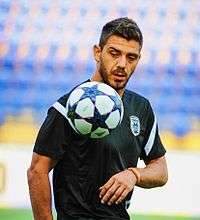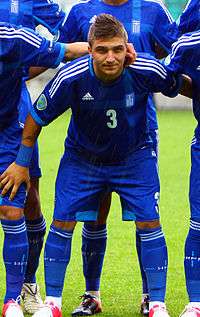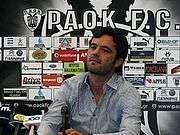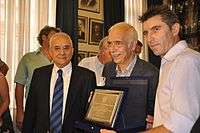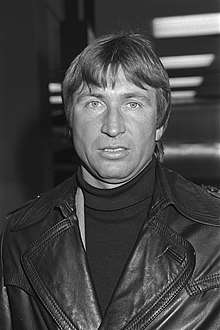PAOK FC
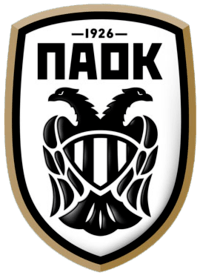 | ||||
| Full name |
Πανθεσσαλονικιός Αθλητικός Όμιλος Κωνσταντινουπολιτών Panthessaloníkios Athlitikós Ómilos Konstantinoupolitón (All-Thessalonian Athletic Club of Constantinopolitans) | |||
|---|---|---|---|---|
| Nickname(s) | Δικέφαλος του Βορρά | |||
| Short name | PAOK | |||
| Founded | 20 April 1926 | |||
| Ground | Toumba Stadium | |||
| Capacity | 29,000 (all-seater)[1] | |||
| Owner | Dimera Group limited | |||
| Chairman | Ivan Savvidis[2] | |||
| Manager | Răzvan Lucescu[3] | |||
| League | Super League | |||
| 2017–18 | Super League, 2nd | |||
| Website | Club website | |||
|
| ||||
| Active departments of P.A.O.K. | |||
|---|---|---|---|
| Football (Men's) | Football (Women's) | Basketball (Men's) | |
| Basketball (Women's) | Volleyball | Handball | |
| Water Polo | Swimming | Wrestling | |
| Boxing | Taekwondo | Weightlifting | |
| Cycling | Athletics | Ice hockey | |
PAOK Football Club (Greek: ΠΑΕ ΠΑΟΚ [paok], Πανθεσσαλονίκειος Αθλητικός Όμιλος Κωνσταντινουπολιτών, Panthessaloníkios Athlitikós Ómilos Konstantinoupolitón, "Pan-Thessalonian Athletic Club of Constantinopolitans"),[4] commonly known as PAOK FC or PAOK Salonika or PAOK Thessaloniki or PAOK, is a professional Greek football club based in Thessaloniki, Greece, and one of the top 4 clubs in Greece.
Established on 20 April 1926 by Greek Constantinopolitans who fled to Thessaloniki from the city of Constantinople (present-day Istanbul) in the wake of the Greco-Turkish War, they play their home games at Toumba Stadium, with a capacity of 28,701 seats. Their name, along with the club's emblem, the Byzantine-style double-headed eagle with retracted wings that was adopted three years after the establishment of the club, honours the memory of the people and places (mostly the city of Constantinople) that once belonged to the Byzantine Empire and were invaded and conquered by the Ottoman Empire in 1453. Τhe club is one of the founding members of the Hellenic Football Federation that was formed in 1926.
PAOK currently plays in the top-flight Super League, which they have won twice (1975–76 and 1984–85). They are six-time winners of the Greek Cup (in 1971–72, 1973–74, 2000–01, 2002–03, 2016–17 and 2017–18 seasons). With a 14th-place finish (1995–96) being the worst position ever achieved, the team has never been relegated to a lower national division since its establishment in 1926, a feat equalled only by rivals Olympiacos and Panathinaikos.
The team has appeared several times in the UEFA Europa League, but has yet to reach the group stage of the UEFA Champions League. Their best European performance was in the 1973–74 season, when they reached the quarter-finals of the UEFA Cup Winners' Cup.[5] In addition to this, it is the only Greek team that has more wins than losses in all its European history (62 wins, 51 draws and 57 defeats, as of July 4, 2017); the 0–7 away win over Locomotive Tbilisi on 16 September 1999 in the UEFA Cup is the largest ever achieved[6] by a Greek football club in all European football competitions.[7]
History
Foundation and early years (1926–1945)

PAOK FC is the oldest division of PAOK Sports Club, the successor of Hermes Athletic and Cultural Association (Greek: Ερμής), which was formed in 1875 by the Greek community of Pera, a district of Istanbul (then Constantinople).[8]
The football club was founded in 1926.[9] It was created by Constantinopolitans who fled to Thessaloniki after the Greek defeat in the Greco-Turkish War, although it was open to every citizen of Thessaloniki, leading to a minor rivalry with AEK Thessaloniki, the other Constantinopolitan team of the city, in which played only refugees. The original logo of PAOK was a horseshoe and a four-leaf clover.[10]
PAOK played their first (informal) game on May 4, 1926, at the Thermaikos stadium, defeating Megas Alexandros Thessaloniki 2–1. The first coach of the club spent five years on the team's bench, and was unpaid, Kostas Andreadis.[11] Their first captain was Michalis Ventourelis.[12]

The season 1926–27, PAOK participated in the 2nd division of Macedonia Football Clubs Association Championship, where was also AEK Thessaloniki. The first official match of their history was on December 12, 1926, where they defeated Nea Genea 3–1, for the same division. After winning the championship of the 2nd division, forced by the organizing authority (EPSMTH), to play with all club's from first division, and he had to win them to be promoted. Eventually they won all four teams, Thermaikos with 4–1, Aris with 2–1, Atlantas with 1–0 and Iraklis with 1–0, and was promoted. In 1927–28 they participated for the first time in 1st division EPSM.[13]
The first professional contract was signed by the club on 5 September 1928. The contract stipulated that the French footballer Raymond Etienne—of Jewish descent from Pera Club—would be paid 4,000 drachmas per month. The contract was signed by Dr. Meletiou, the PAOK chairman, and Mr. Sakellaropoulos, the Hon. Secretary.[14]
In early 1929, AEK Thessaloniki was absorbed by PAOK, who then changed their emblem, adopting the two-headed eagle. The eagle symbolizes the origins of the club in the former Byzantine capital, Constantinople, and the legacy of the Greek refugees from the Ottoman Empire.[10]
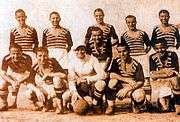
In 1930–31 they made their debut in the Pan-Hellenic Championship, playing their first match against Olympiacos, and ended the season in 5th place.[13] The first foreign coach in the team's history was Austrian Rudolf Gasner, who served PAOK in 1931–32.[11] On 5 June 1932, the Syntrivani Stadium was inaugurated with PAOK's 3–2 victory over Iraklis. Syntrivani was to be their home ground for 27 years.[15]
In 1937, PAOK won their first title, the Macedonia (EPSM or Thessaloniki) Championship, and participated in the Pan-Hellenic Championship, finishing second. The 1937 team included: Sotiriadis, Vatikis, Goulios, Kontopoulos, Bostantzoglou, Panidis, Glaros, Kritas, Ioannidis, Kalogiannis, Koukoulas, Kosmidis, Apostolou, Vafiadis, Vasiliadis, Anastasiadis, Moschidis, Tzakatzoglou, Zacapidas.[16]
On May 28, 1939, PAOK competed for the first time in a Greek Cup final against AEK and was defeated 2–1 on the Apostolos Nikolaidis.[17] In the same season they competed in the final of the 1939–40 Pan-Hellenic Championship, where they lost in double final from AEK. In 1940 they won the North Greece championship.[18]
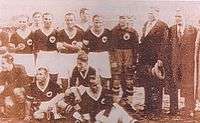
- The beginning of the Greco-Italian War brought the general mobilization in Greece, and the end of every sport activity. PAOK's footballers were presented to Hellenic Army and two of them gave their lives to battle. Goalkeeper Nikos Sotiriadis and left defender Giorgos Vatikis. They are both among the four Greek footballers who have left their last breath on the front. The others was Spyros Kontoulis of AEK and Mimis Pierrakos of Panathinaikos.
- Giorgos Vatikis was the first Greek athlete to "fall" on the Greek-Italian front. As an Warrant Officer. He was 22 years old when he died in Battle of Morava–Ivan. Afterwards, Vatikis was promoted to a lieutenant, and he was awarded the Silver Cross of Valour and the Homeland of Gratitude.
- Nikos Sotiriadis played from 1932 until 1940 in the PAOK team, leaving his last breath on January 28, 1941, in Kleisura, fighting with the rank of Sergeant in the 50th Infantry regiment, in the Greco-Italian War. He was 33 years old.[19]
EPSM Championships (1946–1958)
After the Second World War, in the early 1950s, some important pages of PAOK's history began to be written. At that time, the PAOK academy was created by the Austrian coach, Wilhelm (Willi) Sefzik, and was known as the "chicos of Willi". From the newly founded academy sprang some great football players of the season, such as Leandros Symeonidis, Giannelos Margaritis and Giorgos Havanidis.[20]
In 1948 PAOK won the Macedonia Championship for the second time in history, and then participated in the final phase of the Pan-Hellenic Championship where it was ranked 3rd. PAOK's footballers dedicated the title to the memory of team captain, Thrasyvoulos Panidis, who had lost his life (18 February 1948) in the civil war a few days before the club won it. Panidis played in PAOK since 1930 and had 122 appearances.[21] In 1950 he emerged once again champion of Macedonia,[22] while the next year (1950–51) participated for the second time in the final of the Greek Cup, but lost to Olympiacos.
In 1953 it marked the beginning of successful period for PAOK. During the summer transfers in the team came the Kouiroukidis, Petrides, Progios, Geroudis, Kemanidis, Chassiotis and Angelides.The acquirement of Lambis Kouiroukidis from Doxa Dramas was the major move for club's board, as with Lefteris Papadakis and Christophor Yentzis, created the famous aggressive triple of that age.[10]
For four consecutive seasons (1954, 1955, 1956, 1957) PAOK won the Macedonian championship and participated in the Pan-Hellenic Championship with Yientzis being the first scorer in the season 1953–54 and Kouiroukidis in the season 1955–56.
Under the coach Nikos Pangalos won the Championship in 1954 with 9 wins and only 1 draw. A similar run for the next championship in 1955 with the same coach, with 8 wins and 2 draws. Also, in 1955 PAOK participated for the third time in a final cup and was defeated by Panathinaikos, at Apostolos Nikolaidis Stadium. Ιn 1956, under Hungarian coach Erman Hoffman they won the third consecutive unbeaten championship, with 9 wins and 1 draw. That year first scorer was Kouiroukidis, with 14 goals.[23] The "golden" four years ended in 1957 championship, coached by the Austrian Walter Pfeiffer.[24] This was the 7th title, and last Macedonia Championship in their history, before the establishment of national championship, Alpha Ethniki.
PAOK Stadium (1959–1967)

The Aristotle University of Thessaloniki purchased a two-acre piece of land in the area of Syntrivani Stadium in order to construct new schools. PAOK had to relocate and an area owned by the Ministry of National Defence at Toumba was chosen as the adequate location.
Wing-commander Georgios Themelis, then Minister of National Defence, granted the 7.5 acres to the club and also became the chairman of the committee overseeing the construction of the new stadium. The purchase cost was set at 1.5 million drachmas and was paid by PAOK's administration in 20 six-month instalments of 75,000 drachmas each. On 7 February 1958, a committee of Third Army Corps officers delivered the land to "Double-Headed Eagle's" representatives.
There were still barracks on the premises, housing victims of the Greek Civil War and the 1953 Ionian earthquake. Relocating all these people cost PAOK 70,000 drachmas. The total cost of the stadium's construction amounted to 6 million drachmas, with just 1.1 million coming from the General Secretariat of Sports as subvention. Earthworks started in spring of 1958 and then construction work followed, based on the plans of architect Minas Trempelas and political engineer Antonis Triglianos.
In an attempt to collect the necessary funds, the club issued the "Lottery for the construction of PAOK's new stadium" in April 1958 at a cost of 20 drachmas each. Since 1956, the administration was withholding 15% of the gate income in order to fund the construction of the new stadium. The "Double-Headed Eagle's" fans, apart from money, also contributed to construction by volunteering to work as builders.
The construction of the stadium was completed at a record time of one year. The inauguration event was scheduled for Sunday 6 September 1959 with a friendly encounter against AEK (PAOK prevailed 1–0 with a goal by Kostas Kiourtzis). Prime minister Konstantinos Karamanlis's attendance was cancelled at the last minute. However, several ministers of his government were there for the occasion. As for the ball for the first kick-off, it fell at 17:30 off an airplane of Sedes Military Air Base. On inauguration day, 15,000 PAOK supporters packed Toumba, as that was the stadium's capacity back then. It would increase to 20,000 seats in the following months until it reached a 45,000-seat capacity in the mid-'70s through extensive expansion work.
The attendance mark of 20,000 was broken on 28 April 1963 for the 1–1 draw with Panathinaikos (20,131 spectators), while the 30,000 mark was first surpassed in the 2–0 victory over Olympiacos on 19 March 1967 (31,504 spectators, to be exact). The attendance record remains at 45,252 tickets and was registered on 19 December 1976 in the goalless draw with AEK Athens.[25]
First titles and Europe (1967–1995)
The Greek Cup draw procedures were kind to PAOK, as they didn't need to move from Thessaloniki and ended up playing all their Cup matches leading up to the final in their town. In the last 16 stage and in the semi-finals, the "Double-Headed Eagle" were paired with lower tier clubs. In the quarter-finals, they took their revenge from Aris, eliminating them at Kleanthis Vikelidis Stadium with a 2–1 victory. Due to incidents during that match, the referee had to blow the final whistle ahead of time. As a consequence, Aris players Spyridon and Sidiropoulos were heavily punished at first instance (13 months' and 5 months' incarceration, respectively), but their bans were overturned on appeal. PAOK eliminated Pierikos, Aias Salamina, Aris and progressed to the final with their semi-final victory over PAS Lamia 1964.
Since the previous season, PAOK had insisted on the appointment of a neutral ground to host the final, as the 1970–71 Greek Cup showdown against Olympiacos had been held at Karaiskakis Stadium. PAOK would face Panathinaikos this time around—the Greens had prevailed over Panionios in the semis, but the final was played once again in Athens, at the "neutral" ground of Karaiskakis and not at Apostolos Nikolaidis Stadium. So PAOK returned to the familiar yet inhospitable surroundings of Karaiskakis, far more experienced and readier to claim the 1971–72 Greek Cup title. The players had 10,000 fans on their side and they vowed that it was about time to return with the trophy at Thessaloniki.
It was the fifth final for the "Double-Headed Eagle" and the fourth time that they travelled to Athens for the trophy match. Giorgos Koudas paved the way with his early opener (2') and he also got to seal the deal with his direct free kick in the 89th minute. Papadimitriou got on the scorers’ sheet during stoppage time, reducing distances for Panathinaikos, but to no avail.
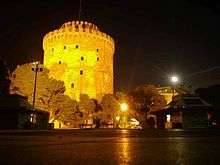
Panathinaikos head coach Ferenc Puskás spoke highly of PAOK's mature game and the fans of the "Double-Headed Eagle" started celebrations in Thessaloniki. As described in a newspaper report, "PAOK's triumph was wildly celebrated. Fans took to the streets, would jump with their clothes in the sea and the White Tower of Thessaloniki fountains, the city was all lit, church bells were ringing, there were chants, songs, tears, embraces, car horns, PAOK banners, all pieces of the triumph puzzle. Right after the final whistle, everyone who was watching the match headed towards the centre of Thessaloniki, using any means available: motorcycles, tricycles, trucks, buses and mainly small cars, all causing traffic congestion and big noise with their horns, trying to make their way to the White Tower. The younger fans would sing “here-there, here-there, we brought the Cup to the White Tower”.
On Thursday 6 July 1972, despite the heat wave in Thessaloniki, at least 2,500 cars headed to the Thessaloniki Airport "Makedonia" to welcome the players of PAOK who were bringing back the trophy. At exactly 16:35 it was announced by the airport loudspeakers that the flight had landed and the first cheers of the public were so loud that the players inside the aircraft heard them. A few minutes later, the door opened and Koulis Apostolidis was the first to appear holding the trophy. Giorgos Koudas and Les Shannon had remained in Athens, to catch a flight to England. The PAOK player would undergo a scheduled operation to deal with a chronic shoulder blade injury.
After their arrival, the players boarded their bus and the motorcade headed towards PAOK's headquarters in the city centre. There, fans and team would celebrate once again the Greek Cup triumph, with the trophy providing the backdrop. The employees of the club had put it on the ledge of a window at PAOK offices.[26]
The 1973–74 Greek Cup final was held at Nea Filadelfia on Sunday 16 June (while the 1974 World Cup was on in Germany) and was the first ever to feature a pre-match ceremony. Les Shannon, due to his English football culture, had acquired special kits for his players to wear in the final—also a first-time experience in Greek football.
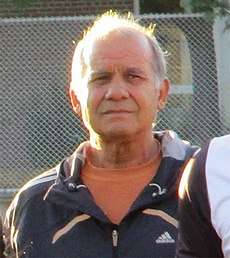
It was a scintillating contest and kept fans on the edge of their seats until its dying seconds. Olympiacos took the lead after 20 minutes of play through Yves Triantafyllos. Konstantinos Iosifidis saw his thunderous belter crash against the crossbar. Dimitris Paridis eventually got the equalizer in the 51st minute, set up by Koudas. In the 66th minute, Gounaris’ handed the ball in PAOK's area and the referee pointed towards the spot kick. Giannis Stefas denied Karavitis at that crucial moment. Seven minutes later, at the opposite side of the pitch, Paridis charged into Olympiacos’ area and was brought down by Viera. Achilleas Aslanidis took the resulting penalty and fired the "Double-Headed Eagle" into the lead. Kritikopoulos turned in his header to make it 2–2 in the 82nd minute, forcing extra time. Nothing of significance happened in the next 30 minutes and a penalty shoot-out would determine the winner. Olympiacos’ Poupakis and Persidis missed their chances, as did PAOK's Koudas. Koulis Apostolidis showed his character with a nerveless spot-kick, the last of the procedure, and celebrated wildly PAOK's second Greek Cup title.[27]
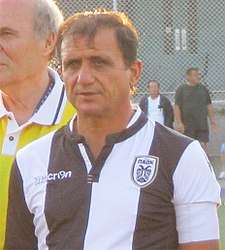
On Friday 12 March 1976, after series of deliberations and two assemblies of the Directors’ Board, PAOK announced that Gyula Lóránt would remain at the helm. Kalafatis and Petridis would also remain on board, but under the condition that nobody would interfere any more with the coach's job, as expressly stated in his contract. Three consecutive victories kept the distance from AEK intact, before it increased on 4 April after the 2–2 draw at Kastoria. The tide would turn around in less than a week though, as PAOK won their postponed game against Panetolikos and then went on to defeat Panionios 4–0 on 11 April. They climbed at the top of the standings for the first time that season, level on points with AEK who lost 1–0 to Panathinaikos.
On matchday 25, AEK were defeated 1–0 by Aris in Thessaloniki and PAOK, winners 3–0 over Panachaiki, were alone at the top of the standings. The league title would be decided in two consecutive high-profile encounters at Toumba Stadium. PAOK prevailed 3–1 over Olympiacos and then Neto Guerino scored the only goal of the match against AEK in the 89th minute, giving the "Double-Headed Eagle" a four-point cushion with three matches to go until the end. The league title was all but guaranteed on the following matchday, when AEK were held to a goalless draw at Serres and PAOK defeated Iraklis at Kaftantzoglio (3–1). The 2–1 loss to Atromitos had nothing but statistical value, as it put a stop to PAOK's undefeated home record. The 1975–76 Alpha Ethniki was sealed with a 4–0 victory over Ethnikos at "Karaiskakis".[28]
The "Double-Headed Eagle" sealed the 1984–85 Alpha Ethniki title with their 2–1 win over Larissa at "Alcazar Stadium", extending their lead to three points, as Panathinaikos and Olympiacos played a 1–1 draw. PAOK continued their winning ways and another draw (AEK–Panathinaikos 1–1) allowed Iraklis to climb in second place, three points behind Walter Skocik’s troops, while Panathinaikos and Olympiacos were at a 4-point distance from top spot.
The venue of the encounter between Iraklis and PAOK on matchday 24 became an issue of controversy, but nevertheless a goal by Giorgos Skartados in the opening minute put the match to rest. The "Double-Headed Eagle" built a five-point distance from Panathinaikos and AEK. Consecutive away draws against Pierikos and Doxa Dramas added some spice to the league and "reminded" Panathinaikos to file a complaint regarding the venue of their loss to Ethnikos back on matchday 21. However, PAOK were on a roll. They defeated OFI 3–0 for the league and then handed Panathinaikos a 4–0 beating in the Greek Cup quarter-finals. On 9 June 1985, PAOK mathematically secured the league title with a goalless draw at Nea Smyrni against Panionios, as Panathinaikos were held to a 2–2 draw by Pierikos. It was the only away point the outfit of Katerini earned that season.
As the Greek League authorities had yet to reach a final verdict on Panathinaikos’ complaint for their match against Ethnikos, there was no decision yet on the time and place of the trophy ceremony. Finally, two days before their home match against Panathinaikos corresponding to the last matchday, PAOK were given the green light. They were presented with the league trophy and had their celebratory lap, Kostas Iosifidis holding the much-coveted silverware.[29]
At the European level, the club made its best ever performance after reaching the quarter-finals of the European Cup in 1973–74 European Cup Winners' Cup where they were knocked out by Milan. PAOK also made a memorable appearance against German giants Bayern Munich in the 1983–84 UEFA Cup, where it was knocked out on penalties after two goalless draws.[30][31]
In 1992, they lost in the Greek Cup to Olympiacos.[32]
Return to the titles (1996–2006)

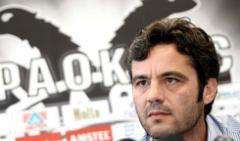
In 1996, Thomas Voulinos handed over the reins of the club to Giorgos Batatoudis. Numerous transfers of well-known players such as Percy Olivares, Zisis Vryzas, Spiros Marangos and Kostas Frantzeskos took place under the new administration. In 1997, having served its five-year ban, PAOK qualified for the UEFA Cup under coach Angelos Anastasiadis. The club's reappearance at European level was marked by a victory and qualification over Arsenal.[33] In 2001 they won the Greek Cup final defeating Olympiacos 4–2.[32] In 2003, they won the Greek Cup final again, defeating Aris 1–0.[32]
The 2003–04 season was an unexpected success. Batatoudis was no longer the major shareholder, and under the management of Anastasiadis, PAOK managed to finish third in the league and to secure participation in the qualifying rounds of the following year's UEFA Champions League. The first match in Toumba finished 2–1 to Maccabi Tel Aviv but was awarded 3–0 against PAOK for fielding a suspended player. The club fielded Liasos Louka, a Cypriot player who was still serving a two-match ban in UEFA competitions (for his sending-off in a UEFA Intertoto Cup tie while playing for Nea Salamis on 8 July 2000).[34] Unfortunately, the team failed to qualify for the group stages, as they were knocked out by Maccabi Tel Aviv in the third qualifying round.[35]
Rolf Fringer was appointed as new coach in September 2004, replacing Angelos Anastasiadis, but after a few games, Fringer was replaced by Nikos Karageorgiou, who led the club to a fifth-place finish in May 2005 and a subsequent 2005–06 UEFA Cup qualification.[36]
By the end of May 2006, the club's dramatic situation started to emerge, with players openly declaring they have been unpaid for months, plus a shocking decision by UEFA to ban the club from participating in the upcoming UEFA Cup,[37] brought the club one step from complete ruin, with the organized fanbase launching an all-out war against Giannis Goumenos during the summer of 2006,[38] going as far as to occupy the club's offices in Toumba stadium for a handful of days. The situation was ever worsening for Goumenos, after many failed deals with possible investors,[39] constant allegations of embezzlement,[40] and especially his decision to sell star player Dimitris Salpingidis to Panathinaikos.[41]
The club appointed Momčilo Vukotić as coach in October 2006, replacing Dumitrescu, who had earlier resigned.[42]
The Zagorakis years (2007–2010)
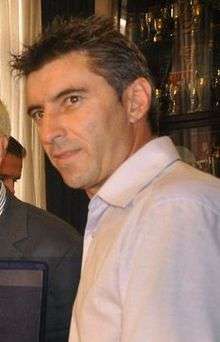
In the summer of 2007, Theodoros Zagorakis assumed presidency of the club, replacing the Nikos Vezyrtzis and Apostolos Oikonomidis administration and thus ushered in a new era.[43]
The plan's first season saw the club eliminated from the Greek Cup by second division club Thrasyvoulos. The early replacement of coach Georgios Paraschos by the well-known established manager Fernando Santos did little to prevent a ninth-place finish in the league.[44]
The club's finances, however, gradually improved, and—thanks to the continuing massive support from fans in the form of season tickets,[45] as well as many new sponsorship deals—the summer of 2008 saw the transfers of widely known internationals like Pablo Contreras,[46] Zlatan Muslimović[47] and Pablo García.[48]
In January 2009, Zagorakis announced the club's intention of building a new training facility complex in the Nea Mesimvria area of Thessaloniki, owned by the club. The administration had already acquired land from the municipality of Agios Athanasios in the previous summer.[49]
The end of the 2008–09 season found PAOK in second place, eight points behind champions Olympiacos, the best place the club had taken since 1985.[50]
European recognition (2010–12)
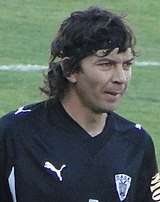
The 2010 league playoff success was swiftly followed by Fernando Santos' announcement of his decision to depart, having concluded his three-year contract as head coach.[51] It was eventually decided in mid-June that Mario Beretta would be his successor.[52]
Beretta was quickly replaced with Pavlos Dermitzakis, veteran PAOK player and Zagorakis' initial choice before reverting to Beretta.[53] Beretta also became the shortest-lived PAOK coach ever, sitting on the bench for just 38 days.[54]
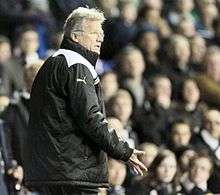
With Dermitzakis at the helm, PAOK faced Ajax and was ultimately eliminated on the away goals rule, managing a 1–1[55] draw in Amsterdam and a thrilling 3–3[56] draw in Thessaloniki. Entering the UEFA Europa League playoff round, PAOK were drawn against Fenerbahçe, also eliminated on the Champions League third qualifying round. This time, PAOK fared much better and after winning the home game 1–0[57] in Thessaloniki, secured a memorable 1–1 draw.[58]
Another defeat against Panathinaikos under Dermitzakis led to his removal on 17 October.[59] His assistant, Makis Chavos, replaced him as caretaker coach.[60]
In 2010–11, PAOK reached the knockout phase in the Europa League, losing 2–1 on aggregate to CSKA Moscow.[61] In the Superleague Greece, PAOK finished fourth in the regular season and secured a place in the 2011–12 UEFA Europa League third qualifying round by finishing second in the playoff round.
The PAOK board then appointed the experienced Romanian László Bölöni as the club's new head coach.[62] Under the leadership of Bölöni, PAOK passed the UEFA Europa League playoff round and entered the group stage, despite the many injured players the club had. On 30 November 2011, PAOK achieved a historic victory[63] against English club Tottenham Hotspur at White Hart Lane, winning 2–1. With this victory, the club qualified for the Europa League round of 32 for the second consecutive year. There they faced Udinese. After a 0–0 draw away in Udine, however, they suffered a 0–3 loss at Toumba Stadium.
Ivan Savvidis era (2012–present)

PAOK entered the 2012–13 Europa League third qualification round, and with a 0–2 away and 4–1 home win over Bnei Yehuda, qualified for the play-off round, where faced Rapid Wien but were eliminated after 2–1 and 3–0 home and away defeats, respectively. PAOK finished the season in second place during the regular period, qualifying for the Superleague playoffs. Giorgos Donis was replaced by technical director and former player Georgios Georgiadis, who was appointed caretaker manager. PAOK managed to win qualification for the third qualifying round of the Champions League in the playoffs after a last game win against PAS Giannina.[64]
In June 2013, PAOK appointed Huub Stevens as their new coach, but he was dismissed in March 2014 after achieving poor results.[65]
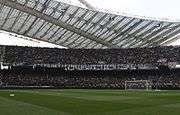
In 2014, the team reached the 2013–14 Greek Cup final, but lost to Panathinaikos.[66]
In 2015, club's new owner Ivan Savvidis paid all of the club's debts to the Greek government, an amount that totalled at €10,886,811.[67] In May, PAOK hired Frank Arnesen as the new club's technical director (sports director). On 18 June 2015, Igor Tudor was hired as the new manager of the club, signing a three-year contract.[68] Tudor was replaced in March 2016 by youth-team coach Vladimir Ivic.[69]
They won the Greek Cup in May 2017, beating AEK Athens in the final in Panthessaliko Stadium, although the match kicked off late due to crowd trouble.[70]
On 11 March 2018, during a match against AEK, the president of the team, Ivan Savvidis, stormed onto the pitch with a pistol in his holster after a late PAOK goal was overturned after protests from AEK, causing the league to be suspended.[71] PAOK was later punished with a reduction of 3 points and the awarding of the game to AEK by 0–3. The 6-point swing was a major blow to PAOK's title hopes and the club was unable to secure the title as AEK Athens were crowned champions with three match-days to go. The club still managed to end their season on a high note by winning their second consecutive Greek Cup beating AEK 2–0 in the Cup final in OAKA, Athens, with the match refereed after many years in Greece by a foreign (Spanish) referee.
Stadiums
Syntrivani Stadium was PAOK's first home ground. It was situated near the Children's Asylum, where the Theological School of Aristotle University is based today.[72]
Their current home ground is Stadio Toumbas, which was opened in 1959, although it has been renovated a number of times since.[73]
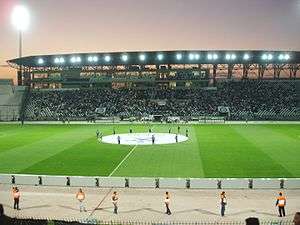
 External view
External view.jpg) Inside view
Inside view
Supporters
.jpg)
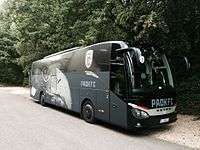
PAOK is one of the most popular football clubs in Greece, with one of the highest average home attendances in Greece. PAOK's traditional fanbase comes from the city of Thessaloniki, where the club is based, as well as most of the rest of Macedonia region and northern Greece.[74]
The main organized supporters of PAOK are known as Gate 4.[75] Gate 4 is where the largest PAOK supporters' clubs assemble. They support all clubs within the PAOK Sports Society, wearing the club's colors and symbols and maintaining firms in every corner of Greece, created in 1976. However, the oldest fan club is "SF PAOK Neopolis Bellos", which was founded in 1963, and was one of the first fan clubs in the country.[76]
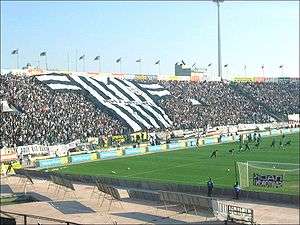
The organized supporters of PAOK (included Gate 4) have over the years become a part of the club by affecting club decisions and by following the club on all occasions. Relations between PAOK's organized supporters and their presidents have occasionally disturbed, and hence have become the cause of ownership change. The reasons for such change include the team's bad results, but also bad management of the club at various times. One of these cases was a movement against the former president of PAOK, Thomas Voulinos. In 1992, organized PAOK fans decided to expel him from the club, leading to their halting of the UEFA Cup home match against Paris Saint-Germain in Toumba by invading the pitch to interrupt the game. The club was punished by UEFA with a 2-year exclusion from any European competition, receiving a painful financial setback. The president of PAOK explicitly accused the president of Gate 4 of being responsible for what had happened. The French newspaper "L'Équipe" used the title "Thessaloniki was crazy" in its match report, while a Paris Saint-Germain member said: "I have not seen such a show, with such furious fans". The beginning of the end of his presidency came on 6 November 1995 when, in a match between PAOK and AEK, extensive violence took place at Toumba. A few months later, Thomas Voulinos left the club.[77][78][79][80][81]
Supporters are also renowned for fireworks, with small and large banners displayed in the stands, and for noisy and constant cheering. One of the biggest banners in the world was created by fan club Michaniona.[82] They maintain a strong friendship with the supporters of Serbian club Partizan, the Grobari. There have been many occasions where fans from both clubs traveled to watch each other's games.[83] PAOK fans also have good relations with the fans of OFI Crete, a friendship that has been build mainly around their sharing of the same club colours.[84] The friendship is supported by an annual exchange of tickets and a typically strong atmosphere in their matches. They additionally also maintain good relations with fans of Panionios.
In the night of 4 October 1999 a road accident took place in the Vale of Tempe, Thessaly, with six fans of the team killed. An ceremony in commemoration of the incident has taken place every year since.[85]
Rivalries
.jpg)
The rivalry between Olympiacos and PAOK, is long-standing, emerging in the 1960s, when the infamous case of Giorgos Koudas' transfer from PAOK to Olympiacos occurred.[86]
A long-time rivalry also exists between PAOK and local rivals Aris.[87]
Panathinaikos and AEK Athens are also considered major rivals due to the bitter rivalry of citizens between Thessaloniki of Macedonia and Athens.[88]
Badge and team colours
The team's traditional colours are black, as sadness for the Asia Minor Catastrophe of 1922 and the end of the Greek presence in Anatolia, and white as hope for recovery.[89] PAOK's traditional home colours are black and white striped shirt. Shorts and socks are usually black with white lines, but it's never the same for a long time. For many seasons in history the shorts were white with black lines. In general, there is nothing stable for a long period. In the club's 91-year history there are over 100 changes, with variations of black and white with shirt and shorts. In addition to classic black and white, the club has used purple, blue, orange, silver and red as an alternative. Every year there are small or big changes.[90] In 1926, the first shirt was black with white collar, and also white shorts.[91] In 1931, the club used a black-and-white shirt with horizontal strips, and also white shorts. Similar appearance was used in 1953 but shorts was black. In 1967–68, for the first time appeared with white shirt, white shorts and white socks.[92] Similar appearances occurred in 1980–82,[93] 1984–85,[94] and 1987–88.[95] In 1970–71, for the first time appeared with black shirt, black shorts and black socks.[96] On January 2016, PAOK presented an anniversary jersey for the 90th birthday of the club. The jersey was designed by Macron. His features were the big, white collar, the thick cords, a variation of the double-headed eagle, the logo of the 90 years on the sleeve, and the first characteristic logo of the team can be found printed on the backneck. Τhe anniversary shirt is a copy of 1966's jersey.[97] The current home kit designed by Macron. Ιn 2016–17, the kit was the classic band white colors of the club developed in vertical bands with side and front piping color of gold. The collar is enriched in the back by the press of the Club name.[98]
Crest
The first logo of PAOK was a horseshoe and a four-leaf clover, that was proposed by the member of board Kostas Koemtzopoulos.[99] The double-headed eagle was chosen as symbol of the club in 1929. Unlike other Byzantine-style eagles, the wings of the eagle are mournfully closed.[100] Under the leadership of Ivan Savvidis a gold stripe was added to the crest, as a symbol of glory and renaissance of the club.[101]
Kit evolution
First
|
1925–26[91]
|
1936–37[102]
|
1938–39[103]
|
1970–71[96]
|
1984–85[104]
|
1990–91[105]
|
2002–03[96]
|
2004–05[96]
|
|
2007–08[106]
|
2014–15[107]
|
2015–16[108]
|
2016–17[109]
|
Alternative
|
1982–83[110]
|
2000–01[111]
|
2001–02[112]
|
2002–03[113]
|
2014–15[107]
|
2015–16[108]
|
2016–17[109]
|
2017–18
|
Shirt sponsors and manufacturers
Until the 1980s, when football in Greece was amateur, the team jerseys had only the emblem and the number of each player. When football became professional (in 1980), then companies began to become official sponsors of the club.[114]
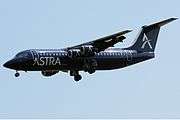
In 1983, Suzuki Motor Corporation became the club's first shirt sponsor for one season.[114] After one-and-a-half years without a jersey sponsor, οn January 2008, there was an agreement with the natural gas supply corporation of Greece, DEPA. The agreement was two-and-a-half years, and the deal is worth €3 million.[115] At the start of the 2010–11 season, the club's main shirt sponsors was Pame Stoixima, which also sponsored them in 1987–88. The agreement was a three-year term,[116] for €1.5 million a year.[117] The collaboration with Pame Stoixima continued for another 2 years. For the 2013–14 season, the club received €1.5 million a year,[118] and for the next €1.8 million.[119] On 22 September 2015, the club announce a two-year deal with sportingbet.gr.[120] The shirt deal was €1.2 million a year.[121] On 30 June 2017, PAOK signed a three-year deal with online betting company "Stoiximan" as shirt sponsor.[122] The new €1.8-million-a-year shirt deal is worth €5.4 million over three years.[123]
ABM Diffusion became the kit manufacturer of PAOK for two years, until 1995.[124] Puma returned again for 2 years, before Adidas started a second spell in 1997. Adidas remained for nine years, followed by PUMA's third period of cooperation with PAOK.[125] Umbro became kit manufacturer of club again,[126] before the agreement with nike in 2013.[127] since 2015, the current kit manufacturer is Macron.[128]
| Overview Kit manufacturers and shirt sponsors | |||||||||||||||||||||||||||||||||||||||||||||||||||||||||||||||||||||||||||||||||||||||||
|---|---|---|---|---|---|---|---|---|---|---|---|---|---|---|---|---|---|---|---|---|---|---|---|---|---|---|---|---|---|---|---|---|---|---|---|---|---|---|---|---|---|---|---|---|---|---|---|---|---|---|---|---|---|---|---|---|---|---|---|---|---|---|---|---|---|---|---|---|---|---|---|---|---|---|---|---|---|---|---|---|---|---|---|---|---|---|---|---|---|
| |||||||||||||||||||||||||||||||||||||||||||||||||||||||||||||||||||||||||||||||||||||||||
Honours
Domestic
- Greater Greece Cup
- Winners (1): 1973[130]
European competitions
- UEFA Champions League:
- Round of 16 (1): 1976–77
- UEFA Cup Winners' Cup:
- Quarter-finals (1): 1973–74
European record
PAOK's best European performance was in the 1973–74 season, when they reached the quarter-finals of the UEFA Cup Winners' Cup.[5]
UEFA ranking
- As of 31 August 2018
| Rank | Country | Team | Coeff. |
|---|---|---|---|
| 47 | Celtic | 31.000 | |
| 48 | Braga | 30.500 | |
| 49 | PAOK | 29.500 | |
| 50 | Club Brugge | 29.500 | |
| 51 | Galatasaray | 29.500 | |
Players
Current squad
- As of 21 September 2018[131]
Note: Flags indicate national team as defined under FIFA eligibility rules. Players may hold more than one non-FIFA nationality.
|
|
Out of Team
Note: Flags indicate national team as defined under FIFA eligibility rules. Players may hold more than one non-FIFA nationality.
|
Out on loan
Note: Flags indicate national team as defined under FIFA eligibility rules. Players may hold more than one non-FIFA nationality.
|
|
Academy and teams
PAOK FC Sport Center is the training ground of PAOK and Academy base, located in Nea Mesimvria area. The construction started under the presidency of Theodoros Zagorakis.[132][133]
Retired numbers
- 12 – in honour of the fans, considered the "12th player" of the team in the pitch. The only player who had the number 12 in his shirt was Joe Nagbe. The last time was on 28 May 2000.[134]
- 17 – in honour of Panagiotis Katsouris, a PAOK player that died in 1998 in a car accident.[135]
Club Captains
|
|
Affiliated clubs
Since 2013, PAOK maintains a cooperation with Juventus on the academies sector.[136]
National team players
A number of PAOK players have represented the Greece national team, the first official international being Nikos Sotiriadis. The record number of PAOK players for Greece was six, which happened on two occasions in 1981. The first PAOK player to captain Greece was Stavros Sarafis.[137]
Management
Board of Directors
|
Technical and Medical staff
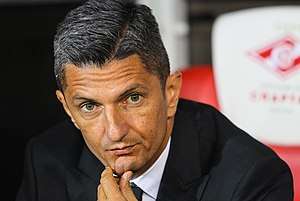
|
|
PAOK FC presidents
|
Notable managers
[72][152] The following managers won at least one trophy when in charge of PAOK:
| Name | Period | Trophies |
|---|---|---|
| 1947–1948 | ||
| 1949–1950 | ||
| 1955–1956 | ||
| 1956–1957 | ||
| 1971–1974 | 2 | |
| 1975–1976 | ||
| 1984–1985 | ||
| 2000–2001 | ||
| 2002–2003 | ||
| 2016–2017 | ||
| 2017–Present |
Records and statistics
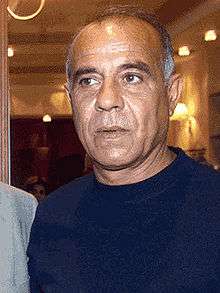
One-club men
| Player | Nationality | Position | Debut | Last match |
|---|---|---|---|---|
| Giorgos Koudas | MF | 1963 | 1984 | |
| Stavros Sarafis | FW | 1968 | 1981 | |
| Konstantinos Iosifidis | DF | 1971 | 1985 |
Most league appearances and top scorer
Giorgos Koudas holds the record for most PAOK league appearances, having played 504 matches (607 overall)[156] between 1963 and 1984.[157]
Stavros Sarafis is the club's top goalscorer with 170 goals overall (136 in league matches), being at PAOK between 1967 and 1981.[156][158]
A list of the ten highest appearances and scorers for PAOK (as of 2004) is listed below:[159]
Most league appearances:
|
League top scorers:
|
References
- ↑ "Γήπεδο". paokfc.gr. Retrieved 29 January 2018.
- ↑ "Ιβάν Σαββίδης". paokfc.gr.
- ↑ "Răzvan Lucescu". paokfc.gr.
- ↑ uefa.com Myths, heroes and legends: PAOK in focus
- 1 2 "History". PAOK FC. UEFA. Retrieved 7 July 2015.
- ↑ "Uefa.com: PAOK's history". Uefa.com. 20 Jan 2011. Retrieved 13 May 2016.
- ↑ "Οι μεγαλύτερες σε σκορ νίκες συλλόγων σε ευρωπαϊκές διοργανώσεις". tovivlio.gr. Retrieved 13 May 2016.
- ↑ "History". PAOKFC. Retrieved 26 June 2015.
- ↑ "PAOK THESSALONIKI FC". Soccerway. Perform. Retrieved 24 June 2017.
- 1 2 3 "Αφιέρωμα - PAOKFC".
- 1 2 "90 χρόνια ΠΑΟΚ!90 χρόνια προπονητές!". paokvoice. Retrieved 14 July 2017.
- ↑ "The first captain". paok90. Retrieved 14 July 2017.
- 1 2 "Ο ΠΑΟΚ γιορτάζει 91 χρόνια ζωής". sport24. Retrieved 14 July 2017.
- ↑ "The unknown first foreign player of PAOK Raymond Ettienne". paokmania.gr. Archived from the original on 13 February 2013. Retrieved 10 May 2013.
- ↑ "Σταθμοί στην ιστορία". paokfc. Retrieved 14 July 2017.
- ↑ "Ο πρώτος τίτλος!". paok90. Retrieved 14 July 2017.
- ↑ "First Lost Final". paok90. Retrieved 14 July 2017.
- ↑ Alexander Mastrogiannopoulos (11 Jun 2010). "Greece – Final Tables 1906–1959, 1939–40". RSSSF. Retrieved 16 July 2017.
- ↑ "Από το γήπεδο στο μέτωπο". contra. Retrieved 14 July 2017.
- ↑ "first youth academy".
- ↑ "Όταν ο ΠΑΟΚ έχανε τον αρχηγό του - When PAOK lost its captain".
- ↑ Alexander Mastrogiannopoulos (11 Jun 2010). "Greece – Final Tables 1906–1959, 1949–50". RSSSF. Retrieved 22 July 2017.
- ↑ "Stations-Of-History". paokfc. Retrieved 22 July 2017.
- ↑ "The "golden" three-year period of PAOK". paok90. Retrieved 22 July 2017.
- ↑ "Τούμπα - PAOKFC".
- ↑ "The first title – PAOKFC".
- ↑ "Second Cup – PAOKFC".
- ↑ "The league was sealed – PAOKFC".
- ↑ "Second Greek Championship- PAOKFC".
- ↑ DonMits. "Το καφενειο του ΠΑΟΚτση: UEFA CUP 1983 – 1984: Bayern – ΠΑΟΚ". Retrieved 26 June 2015.
- ↑ phaistos networks s.a. "ΜΕΓΑΛΕΣ ΕΥΡΩΠΑΙΚΕΣ ΣΤΙΓΜΕΣ,ΜΠΑΓΕΡΝ ΜΟΝΑΧΟΥ-ΠΑΟΚ 1983–84,0–0,9–8 ΣΤΑ ΠΕΝΑΛΤΥ.ΒΙΝΤΕΟ". Retrieved 26 June 2015.
- 1 2 3 Jotis Panagiotas (28 May 2015). "Greece – List of Cup Winners". RSSSF. Retrieved 30 August 2015.
- ↑ Administrator. "Η ιστορική πρόκριση του Π.Α.Ο.Κ επί της Άρσεναλ! - magazino24".
- ↑ "PAOK punished with 3-0 loss". UEFA.
- ↑ "Δύο προκρίσεις κι ένας εφιάλτης - inpaok".
- ↑ "PAOK Stories – hellenicaworld".
- ↑ "Εκτός Κυπέλλου UEFA ο ΠΑΟΚ, στη θέση του ο Ατρόμητος". In.gr. Retrieved 26 June 2015.
- ↑ "Ο αποδιοπομπαίος (η)Γούμενος του ΠΑΟΚ". TO BHMA. Retrieved 26 June 2015.
- ↑ "Ελευθεροτυπία - Απογευματινή Αδέσμευτη Εφημερίδα".
- ↑ "Στο σκαμνί για υπεξαίρεση ο Γούμενος". Ελευθεροτυπία. Retrieved 26 June 2015.
- ↑ ΔΗΜΗΤΡΗΣ ΚΡΙΤΗΣ (16 August 2006). "Εκλεισε στον Παναθηναϊκό ο Σαλπιγγίδης". Contra.gr. Retrieved 26 June 2015.
- ↑ "PAOK appoint Vukotic". World Soccer. 13 October 2006. Retrieved 5 September 2015.
- ↑ Σταύρος Σουντουλίδης. "Aπ' τον Παντελάκη στον Ivan Savvidi!". gazzetta.gr.
- ↑ Νίκος Δραγόλιας (10 July 2016). "Όταν ο Σάντος αμφισβητήθηκε έντονα στον ΠΑΟΚ". sport24.gr.
- ↑ ΣΑΚΗΣ ΓΚΙΝΑΣ (5 September 2008). "Ρεκόρ στα εισιτήρια διαρκείας ο ΠΑΟΚ". Contra.gr. Retrieved 26 June 2015.
- ↑ "Archived copy". Archived from the original on 21 July 2011. Retrieved 17 June 2011.
- ↑ "ΠΑΟΚ – Υπέγραψε ο Μουσλίμοβιτς για τρία χρόνια στον ΠΑΟΚ – Αθλητισμός – Ποδόσφαιρο – Σούπερ Λίγκα – in.gr". In.gr. Archived from the original on 21 February 2015. Retrieved 26 June 2015.
- ↑ "Ντεμπούτο για Πάμπλο Γκαρσία". sport-fm.gr. Retrieved 26 June 2015.
- ↑ "Archived copy". Archived from the original on 12 February 2010. Retrieved 23 February 2010.
- ↑ Αντώνης Τσακαλέας (11 May 2016). "Αδερφέ, εσύ ήσουν ΠΑΟΚ και απλά δεν το ήξερες..." contra.gr.
- ↑ ΣΑΚΗΣ ΓΚΙΝΑΣ (18 May 2010). "Το αντίο του Φερνάντο Σάντος (vids)". Contra.gr. Retrieved 26 June 2015.
- ↑ apngr. "Ο Μάριο Μπερέτα είναι επίσημα προπονητής του ΠΑΟΚ". -APN.GR. Retrieved 26 June 2015.
- ↑ "PAOK swap Beretta for Dermitzakis". UEFA.com. 24 July 2010. Retrieved 26 June 2015.
- 1 2 "Το... νέο ρεκόρ του Μπερέτα". Ελευθεροτυπία. Retrieved 26 June 2015.
- ↑ ΑΠΟΣΤΟΛΗΣ ΧΟΡΤΑΤΟΣ (28 July 2010). "Άγιαξ – ΠΑΟΚ 1–1 (vids)". Contra.gr. Retrieved 26 June 2015.
- ↑ ΣΤΑΥΡΟΣ ΚΑΡΑΪ́ΝΔΡΟΣ (4 August 2010). "ΠΑΟΚ-Αγιαξ 3–3 (VIDEOS)". Contra.gr. Retrieved 26 June 2015.
- ↑ ΣΤΑΥΡΟΣ ΚΑΡΑΪ́ΝΔΡΟΣ (19 August 2010). "ΠΑΟΚ-Φενέρμπαχτσε 1–0 (videos)". Contra.gr. Retrieved 26 June 2015.
- ↑ ΓΙΑΝΝΗΣ ΖΩΙΤΟΣ (26 August 2010). "Φενέρμπαχτσε-ΠΑΟΚ 1–1 παρ. (vid)". Contra.gr. Retrieved 26 June 2015.
- ↑ ΣΑΚΗΣ ΓΚΙΝΑΣ (17 October 2010). "Παρελθόν ο Δερμιτζάκης από τον ΠΑΟΚ". Contra.gr. Retrieved 26 June 2015.
- ↑ Πάνος Χρυσάνθου. "Μάκης Χάβος:Το DNA του μαχητή!". shootandgoal.com.
- ↑ "2010/11: Round of 32". UEFA Europa League. UEFA. Retrieved 31 August 2015.
- ↑ ΣΑΚΗΣ ΓΚΙΝΑΣ (9 June 2011). "Η παρουσίαση του Λάζλο Μπόλονι από τον ΠΑΟΚ: Δεν είμαι δικτάτορας (videos)". Contra.gr. Retrieved 26 June 2015.
- ↑ "Tottenham Hotspur – PAOK FC 1–2". paokfc.gr. Archived from the original on 27 May 2012. Retrieved 2 December 2011.
- ↑ Onsports Team (5 May 2015). "Η ζωή στον ΠΑΟΚ μετά τον Σάντος". onsports.gr. Retrieved 29 June 2017.
- ↑ "Huub Stevens dismissed by PAOK Salonika after Greek Super League disappointment". Sky Sports News. 3 March 2014. Retrieved 5 September 2015.
- ↑ "Greece Cup: Archive". Soccerway. Perform. Retrieved 7 July 2015.
- ↑ Πληρώθηκαν τα χρέη, 14.15 ο Ιβάν στην ΦΑΕ! (in Greek). OlaPaok.gr news site. 12 May 2015. Archived from the original on 21 May 2015.
- ↑ Ιγκόρ Τούντορ για τρία χρόνια στον ΠΑΟΚ (in Greek). 18 June 2015.
- ↑ Associated Press (9 March 2016). "PAOK Salonika sack Igor Tudor, appoint Vladimir Ivic as successor". ESPN. Retrieved 25 June 2017.
- ↑ "Crowd violence delays the start of the Greek Cup final". BBC. Retrieved 6 May 2017.
- ↑ "Greek Super League: Angry PAOK owner Ivan Savvidis storms pitch with gun - Goal.com". goal.com.
- 1 2 "The first PAOK's home". History: The Stadium. PAOK. Retrieved 22 June 2017.
- ↑ "PAOK Thessaloniki FC: Venue". Soccerway. Perform. Retrieved 22 June 2017.
- ↑ "Ο οπαδικός χάρτης της Ελλάδας". sdna. 17 March 2015. Retrieved 5 July 2017.
- ↑ paok26.wordpress G4 – 1976
- ↑ 1926.gr ΑΦΙΕΡΩΜΑ Σ.Φ. Π.Α.Ο.Κ. ΝΕΑΠΟΛΗΣ ΜΠΕΛΛΟΣ 1963–2013 | 50 ΧΡΟΝΙΑ
- ↑ "Η "μαύρη νύχτα" του ΠΑΟΚ με την Παρί (pics & vids)". gazzetta. 1 October 2016. Retrieved 5 July 2017.
- ↑ "Η "μαύρη" επέτειος του ΠΑΟΚ (video)". onsports. 1 October 2011. Retrieved 5 July 2017.
- ↑ "<<Έφυγε>> ο πρώην πρόεδρος του ΠΑΟΚ θωμας Βουλινός". tvxs. 10 January 2012. Retrieved 5 July 2017.
- ↑ "History PAOK in Europe". paokfc. Retrieved 5 July 2017.
- ↑ "Σύνδεσμοι Φιλάθλων στην Ελλάδα - Fan clubs in Greece". tvxs. 18 April 2015. Retrieved 5 July 2017.
- ↑ "Το μεγαλύτερο πανό της Ευρώπης ανήκει στον ΠΑΟΚ!". protothema. 21 February 2014. Retrieved 5 July 2017.
- ↑ sport24 ΠΑΟΚ - Παρτίζαν: Μία φιλία που συνεχώς δυναμώνει
- ↑ gentikoule Κάπως έτσι ξεκίνησε η φιλία ΟΦΗ – ΠΑΟΚ
- ↑ "Τέμπη 4/10/1999: Η μαύρη μέρα του ΠΑΟΚ". agones.gr.
- ↑ "Derby between the north and the south". FootballDerbies.com.
- ↑ "Aris Saloniki – Paok Saloniki". FootballDerbies.com.
- ↑ "Football Derby matches in Greece". FootballDerbies.com.
- ↑ "Η ιστορία του ΠΑΟΚ - History of PAOK". sansimera.gr.
- ↑ "Όλες οι 117 φανέλες ΠΑΟΚ!". inpaok.com.
- 1 2 paokfc.gr Happy anniversary PAOK!
- ↑ "Ο Νικηφόρος Φλώρινας στο δρόμο του ΠΑΟΚ! - Paokmania.Gr - Το ανεξάρτητο site των οπαδών του ΠΑΟΚ". paokmania.gr.
- ↑ footballstatssince1980.blogspot.gr Η ΙΣΤΟΡΙΑ ΤΟΥ ΠΑΟΚ ΧΡΟΝΙΑ-ΧΡΟΝΙΑ (1980–1984)
- ↑ paokmania.gr Ο ΠΑΟΚ κλειδώνει τον τίτλο (9/6/1985)!
- ↑ alithinihistoria.wordpress.com ΠΑΟΚ 1987–88
- 1 2 3 4 contra.gr PHOTOSTORY: Οι εμφανίσεις του ΠΑΟΚ στην Α' Εθνική
- ↑ "90 Χρόνια Ιστορίας – Μία φανέλα". paokmania.gr.
- ↑ "Αυτές είναι οι εμφανίσεις του ΠΑΟΚ για τη σεζόν 2016–2017". contra.gr.
- ↑ "Ο ΠΑΟΚ γιορτάζει σήμερα 90 χρόνια ένδοξης ιστορίας". metrosport.gr.
- ↑ "ΙΣΤΟΡΙΑ". acpaok. 7 June 2017. Retrieved 3 July 2017.
- ↑ "Το νέο λογότυπο του ΠΑΟΚ". contra.gr.
- ↑ karfitsa.gr Σπάνιες φωτογραφίες και η ιστορία γηπέδου του ΠΑΟΚ (ΦΩΤΟ)
- ↑ paokmania.gr H πρώτη πρόκριση σε τελικό Κυπέλλου...
- ↑ gazzetta.gr ΠΑΟΚ: Σαν σήμερα το 1985 στέφθηκε πρωταθλητής στη Νέα Σμύρνη
- ↑ http://www.contra.gr/Basketball/article3589317.ece/BINARY/w460/1990-91.jpg
- ↑ "Οι σημαντικότερες εμφανίσεις που φορέθηκαν". contra.gr.
- 1 2 paokfc.gr Εικόνες από την παρουσίαση της νέας φανέλας
- 1 2 gazzetta.gr Φανέλα και χορηγό παρουσίασε ο ΠΑΟΚ!
- 1 2 olimpopress.it Macron e Paok Fc presentano le nuove maglie per la stagione 2016/17
- ↑ gazzetta.gr Οταν ο ΠΑΟΚ αγωνίστηκε με... κόκκινα!
- ↑ paokmania.gr 2000-01
- ↑ "Ένας ΠΑΟΚ με άλλα χρώματα… (pics)". gazzetta.gr.
- ↑ http://www.balleto.gr/assets/media/PICTURES/TOP%20TEN/23198.jpg
- 1 2 gazzetta.gr Από το 80΄ είχες πάντα χορηγό…
- ↑ contra.gr Χορηγός στη φανέλα η ΔΕΠΑ
- ↑ onsports.gr onsports.gr
- ↑ paokmania.gr Με χορηγό στη φανέλα
- ↑ sportandbusiness.gr Με τον ΟΠΑΠ στην φανέλα και φέτος
- ↑ "Άγριο τσεκούρι από τον ΟΠΑΠ για τις χορηγίες στις φανέλες! Πόσα θα λάβουν Ξάνθη, Πανθρακικός και οι άλλες ομάδες της Super League - Thrakisports". thrakisports.gr. 25 June 2015.
- 1 2 paokfc.gr Sportingbet become PAOK FC "Golden Partner"
- ↑ sdna.gr Stoiximan become PAOK FC Grand Sponsor
- ↑ paokfc.gr Stoiximan become PAOK FC Grand Sponsor
- ↑ sdna.gr Αυτό είναι το deal του ΠΑΟΚ με τη Stoiximan.gr
- ↑ "Paok Salonicco - ABM abbigliamento tecnico sportivo". www.abmdiffusion.it.
- 1 2 sentragoal.gr Συμφωνία με PUMA
- 1 2 onsports.gr Τελειώνει η συμφωνία με την Umbro
- 1 2 voria.gr Ανακοινώθηκε η συνεργασία του ΠΑΟΚ με τη Nike
- 1 2 sport24.gr Ο ΠΑΟΚ θα φορά Macron
- ↑ sport24.gr Παρουσίασε τις νέες φανέλες ο ΠΑΟΚ
- ↑ "Το κύπελλο "Μεγάλης Ελλάδας" στα χρόνια της Χούντας". sportsnews.
- ↑ "First Team". paokfc.gr. Retrieved 21 September 2018.
- ↑ "Νέα Μεσημβρία - PAOKFC".
- ↑ "Αθλητικό Κέντρο ΠΑΟΚ". gazzetta.gr.
- ↑ "Retired PAOK FC Numbers". isovitis.gr. Retrieved 12 June 2017.
- ↑ "Retired PAOK FC Numbers". sport24.gr. Retrieved 12 June 2017.
- ↑ "Συνεργασία ΠΑΟΚ-Juventus".
- ↑ "Special". History: PAOK's National players. PAOK. Retrieved 23 June 2017.
- ↑ "Διοίκηση - PAOKFC".
- ↑ businessregistry.gr
- 1 2 "Ξεκινά το Δ.Σ. της ΠΑΕ ΠΑΟΚ με πρόεδρο τον Ιβάν Σαββίδη". sdna.gr.
- ↑ "Διευθυντής ανάπτυξης ποδοσφαιρικού τμήματος ο Μάριο Μπράνκο - PAOKFC". paokfc.gr. 23 August 2018.
- ↑ "Τεχνικός διευθυντής ακαδημιών ο Αλσίνα - PAOKFC". paokfc.gr. 12 July 2017.
- ↑ "Σύμβουλος του ΠΑΟΚ ο Τεβεκέλης". gazzetta.gr.
- ↑ "Κυριάκος: «Ο ΠΑΟΚ μόνος του, καμία συμφωνία κάτω από το τραπέζι»". www.metrosport.gr.
- ↑ "Τεχνικό επιτελείο- PAOKFC".
- ↑ "Αυτό είναι το τιμ του Στανόγεβιτς στον ΠΑΟΚ - Filathlos.gr - Το Εγκυρότερο Αθλητικό Blog!". Filathlos.gr.
- ↑ "Team manager o Κωνσταντινίδης, στις Ακαδημίες ο Πουρλιοτόπουλος". sport24.gr.
- ↑ "Εκγύμναση υπό την επίβλεψη του γιατρού Παπακώστα". sport24.gr.
- ↑ "Εργομετρικά και ποδόσφαιρο για τον ΠΑΟΚ". www.metrosport.gr.
- ↑ "Νέο - παλιό πρόσωπο η διατροφολόγος - Paokmania.Gr - Το ανεξάρτητο site των οπαδών του ΠΑΟΚ". paokmania.gr.
- ↑ "Aπ' τον Παντελάκη στον Ιβάν!". gazzetta.gr.
- ↑ "History Titles". Retrieved 3 July 2017.
- ↑ "Γκιούλα Λόραντ, πεθαίνοντας στον πάγκο του ΠΑΟΚ". wordpress.com. 30 May 2010.
- ↑ "Ο μοναδικός Ιωσηφίδης - inpaok.com". inpaok.com. 19 September 2015.
- ↑ "Εφημερίδα Μακεδονία". makthes.gr.
- 1 2 "Η ομαδάρα του ΠΑΟΚ, που διέλυσε τη Λυών" [The day PAOK defeated Lyon]. gazzetta. 7 November 2016. Retrieved 3 July 2017.
- ↑ "H ζωή του Γιώργου Κούδα" [The life of Giorgos Koudas]. gazzetta. 23 November 2015. Retrieved 3 July 2017.
- ↑ Alexander Mastrogiannopoulos (19 January 2003). "Greece – All Time Top Scorers 1959/1960 – 1998/1999". RSSSF. Retrieved 23 June 2017.
- ↑ Stelios Grigoriadis, Giorgos Bouzos, Giorgos Trachopanidis, Costas Petrotos, Giorgos Karagiannis (2004). ΠΑΟΚ 2004 τσάμπιονς λιγκ Η Υπέρβαση [PAOK 2004 Champions League, Full Information] (in Greek). Thessaloniki: Panagiotis G. Antonopoulos. p. 191.
External links
| Wikimedia Commons has media related to PAOK FC. |
Official websites
- Official website (in English) (in Greek) (in Russian)
- PAOK at Super League (in English) (in Greek)
- PAOK at UEFA
- PAOK at FIFA
Media
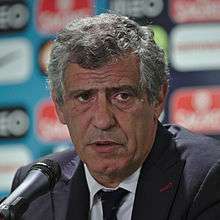
.jpg)
